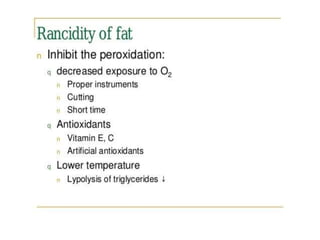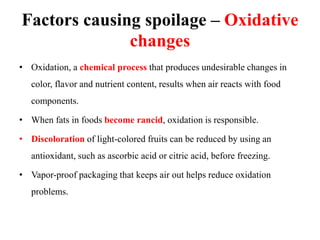Factors causing spoilage
- 1. Factors causing Spoilage – Carbohydrates, Proteins, Fats – rancidity, Oxidative changes and enzymes Jasmine Juliet .R Teaching Assistant Biotechnology Dept AC&RI, Madurai.
- 2. Food Spoilage • Food spoilage is the process where a food product becomes unsuitable for human consumption. • Due to food spoilage, one-third of the world's food is lost every year. • Signs of food spoilage may include an appearance different from the food in its fresh form, such as: a change in color, a change in texture, an unpleasant odour, or an undesirable taste. • The food item may become softer than normal.
- 6. Causes of Food Spoilage • There are mainly three types of causes of food spoilage viz. biological, chemical and physical causes. • Biological causes comprise of growth and activity of microorganisms such as bacteria, yeast and moulds; activity of food enzymes and damage due to pests, insects and rodents etc. • Chemical causes include reaction with oxygen and light and chemical reactions within food constituents. • Physical causes consist of temperature and physical abuse.
- 11. Causes of Food Spoilage • Biological, Chemical, Physical factors can act together. • For example, bacteria, insects, and light, all can be operating concurrently to spoil food in a field or in a warehouse. • Similarly, heat, moisture, and air at the same time affect the multiplication and activities of bacteria and chemical activities of food enzymes.
- 13. Factors causing spoilage • The major types of spoilage that occur in foods are due to microbiological, biochemical, physical and chemical changes. These include: I. Growth and activity of microorganisms such as bacteria, yeast and moulds. II. Activities of food enzymes, present in all raw foods, promote chemical reactions within the food affecting especially the food colour, texture and flavour. III. Inappropriate holding temperatures (heat and cold) for a given food.
- 14. Factors causing spoilage IV. Gain or loss of moisture. V. Reaction with oxygen and light causing rancidity and colour changes due to oxidative reactions. VI. Physical stress or abuse. VII. Damage due to pests, insects and rodents etc. VIII. Non-enzymatic reactions in food such as oxidation and mechanical damage
- 15. Spoilage due to growth and activity of microorganisms • Most significant deteriorative changes occur in foods due to microorganisms present in air, soil, water and on foods. • They use our food supply as a source of nutrients for their own growth, which results in deterioration of food and render our food supply unfit for consumption. • Microbes spoil any food in many ways: • by increasing their number; by utilizing nutrients; • by producing enzymatic changes; by contributing off-flavours; • by breakdown of a product; and by synthesis of new compounds. • The three major types of microorganisms which cause food spoilage are bacteria, yeasts and moulds.
- 21. Factors causing spoilage – Carbohydrates, Proteins,Fats
- 23. Factors causing spoilage - Carbohydrates
- 29. Factors causing spoilage - Proteins
- 31. Factors causing spoilage - Lipids
- 37. Factors causing spoilage – Rancidity, Oxidative changes, Enzymes
- 41. Factors causing spoilage – Oxidative changes • Food spoilage by chemical oxidation represents one of the major problems for society. • Typically, an exposure of a food or beverage to oxygen would trigger a chain of chemical reactions involving proteins, pigments, fatty acids, and lipids, producing other compounds with undesirable biochemical properties including toxicity, as well as undesirable taste, smell, and color. • Many of these processes occur via free radical mechanisms and involve chain reactions.
- 42. Factors causing spoilage – Oxidative changes • Oxidation, a chemical process that produces undesirable changes in color, flavor and nutrient content, results when air reacts with food components. • When fats in foods become rancid, oxidation is responsible. • Discoloration of light-colored fruits can be reduced by using an antioxidant, such as ascorbic acid or citric acid, before freezing. • Vapor-proof packaging that keeps air out helps reduce oxidation problems.
- 46. Factors causing spoilage - Enzymes

























































